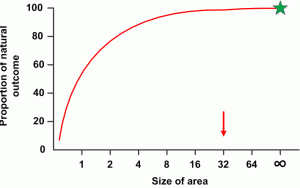Over the last 50 years I have attended about 200 ecological conferences. The best meetings have followed a series of practices that I present here. This list can be viewed as a practical example of adaptive management, since conferences that score low on the scale of suggestions here have in my opinion been less successful. Two major items drive a conference – papers and posters. Three other items are critical – good food, a spacious venue, and well organized symposia, but I will not discuss these three here.
Papers are presented at conferences largely as powerpoint talks. Most of these talks are 15 or 20 minutes but the rules for good powerpoint talks are quite simple.
- A good slide in Powerpoint makes no more than 2 or 3 points, and these points should augment, emphasize, and explain the speaker’s words.
- For complicated subject matter, use 2 or 3 simple figures rather than one complex, cluttered and unclear figure. A series of slides that build on each other is very effective.
- Effective labels for slides are briefer and larger than those for publication. Titles should be 40-44 point font (14 mm) and text 32 point (11 mm). Bold and italic labelling should be saved for special emphasis.
- Slide titles should be relatively short – 1 line only.
- If using colour, stick to primary, bright, and clear colours.
- Do not use a photo as a background for the slide. It may be good artistically but it distracts from the points you are making.
- Word slides should contain no more than 5 short statements. The information on the slide should be simplified to the point of being skeletal. It is up to the presenter to fill in gaps. You should never have more than 30 words on a slide. 20 would be better.
- Presenters should not read word slides to the audience. The audience can read the slide faster than the presenter can speak it.
- If all the information on a slide is not valuable to the audience, leave it out. Take the time to adapt figures or tables for your presentation.
- A good average is one slide per minute of talk. If you have more, you are going too fast for the audience.
- If people remember your presentation, they will remember only one or two key points. Summarize these at the end of your talk.
- Never never never put 2 or 3 graphs or photos on a powerpoint slide since no one will be able to read the labels.
- Look at your powerpoints in a bright room and in a dark room and see if you can still read them. You will not know how the conference lighting will be arranged.
- Go to the back of the room and look at your Powerpoint presentation. If you need binoculars to read the slides, go back to step 1.
So if you are giving a 15 minute talk at the next conference you attend, prepare 15 slides in powerpoint. If you are giving a 3 minute speed talk, never have more than 3 slides. Simple arithmetic.
Posters are the next most important communication device used in scientific conferences, and unfortunately posters are typically awful as they are usually constructed with far too much detail. Here are a few rules for posters.
- Focus on 3 points or less. If you can get across even 1 point clearly and quickly to your viewer, your poster is successful. Remember that you will be there to answer questions and fill in details.
- Lengthy poster titles discourage viewers! Titles should be brief, informative, and interesting.
- Text should be readable without strain from 1 m. Height of TITLE text should be about 100 point (3 cm) and height of BODY TEXT should be about 30 point (0.8 cm). Figure labels should be a minimum of 24 point (8 mm). See if you can read it from 1 m distance.
- Use simple fonts such as Arial, Helvetica, or Univers. These are proportionately spaced and conventionally shaped so will not distract from the information they describe.
- Avoid abbreviations and jargon. Avoid all but the simplest tables. No one will read a table with 10 columns and 25 rows.
- Because all graphs should be large, information on graphs should be limited, and labels should be short. Specify measurement units. Provide scales on maps.
- Plan the poster to be read in sections from left to right and top to bottom. Each section should be easily read while standing in one spot.
- Colour keys used consistently throughout the poster make information easier to follow.
- Avoid using photographs as a background for text or figures.
- If your poster has more than 300-400 words, you have too much detail.
- Give an executive summary or abstract of 50 words or less at the start of the poster. What is the question or problem, and what have you achieved in answering it?
- Put a small, clear photo of yourself on the top right of the poster so people will recognize you.
- Provide copies of a one-page printed summary of your poster for viewers who are interested in more detailed information or do not have time to read it, and give your contact information on this page.
- Images should ideally be scanned at the size that they are to be used on the poster (not scanned and then dragged to the appropriate size). Most poster printers can’t process higher than 300dpi, so there’s no point scanning at a resolution higher than this.
- Look at your poster in a bright room and see if it is readable under bright light conditions.
